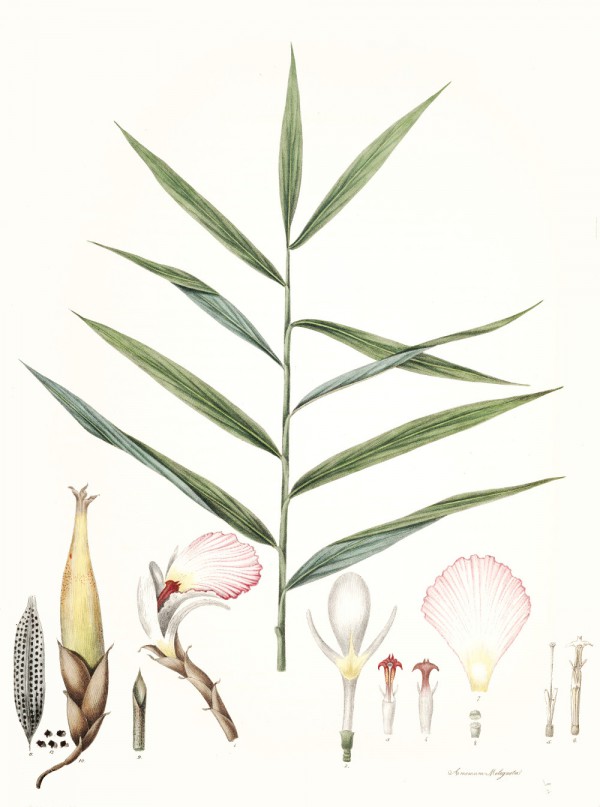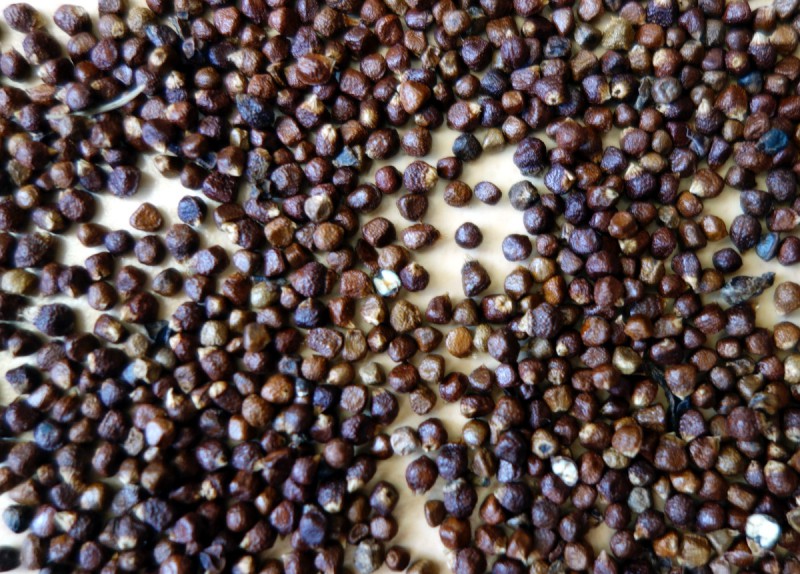Benutzer-Werkzeuge
Aframomum melegueta K. Schum. - Zingiberaceae - Melegueta pepper, grains of paradise, alligator pepper, Guinea pepper, Meleguetapfeffer, Malagettapfeffer, Paradieskörner, Guineapfeffer, Afrikapfeffer
Perennial herb, native to West Africa, also cultivated; flowers trumpet-shaped, white-purple; pods 5-7cm long; seeds small, numerous, reddish-brown.
„Aframomum melegueta is known as famu wisa in Twi to distinguish it from soro wisa (Piper guineense Schum. et Thonn.), and the seeds are often referred to as Guinea grains or Grains of Paradise.“
[The Cultivation of Melegueta Pepper in Ghana., Lock, J.M., Hall, J.B., Abbiw, D.K., Economic botany, 31(3), 1977, 321-330]
The major components of absolute and supercritical CO2 extract of Aframomum melegueta were [6]-paradol (35.1 and 13.3%), [6]-shogaol (21.5 and 6.1%), [6]-gingerdione (9.8 and 28.0%), α-humulene (10.5 and 7.2%) and [6]-gingerol (1.3 and 10.0%).
„However gingerols are thermally unstable and can decompose under high temperature during GC analysis, therefore HPLC was used for oleoresins analysis and phenyl alkenones quantification.“
[Chemical composition of absolute and supercritical carbon dioxide extract of Aframomum melegueta., Fernandez, X., Pintaric, C., Lizzani‐Cuvelier, L., Loiseau, A.M., Morello, A., Pellerin, P., Flavour and fragrance journal, 21(1), 2006, 162-165]
„A total of fifty-nine components were identified in the essential oil of alligator pepper, accounting for 99.4% of the total composition. The oil was dominated by oxygenated monoterpenes (83.3%), with 1,8-cineole (58.5%) and α-terpineol (19.4%) as the major compounds. Monoterpene hydrocarbons gave a minor contribution (14.9%), with β-pinene (7.1%) and α-pinene (2.0%) as the most representative compounds. Interestingly, sesquiterpenoids, which are reported as volatile marker compounds of alligator pepper, were detected in only low levels here (0.6%). The chemical composition of the A. melegueta seed essential oil showed a significant variability depending on the geographic origin and genetic characteristics of the samples. For example, samples from Nigeria exhibited humulene (26.23%), (E)-ocimene (23.22%), (E)-caryophyllene (19.17%), and (S)-2-heptyl acetate (16.22%) as the major volatile constituents [24]. On the other hand, the seeds from the Central African Republic contained high levels of β-pinene (>30%) and about 50% sesquiterpene hydrocarbons [48], and an oil sample from Cameroon was made up of β-caryophyllene (8.5%), α-humulene (31.3%), and their epoxides (17.9% and 27.7%, respectively) [49].“
[Kamte, Stephane L. Ngahang, et al. „Trypanosoma brucei inhibition by essential oils from medicinal and aromatic plants traditionally used in Cameroon (Azadirachta indica, Aframomum melegueta, Aframomum daniellii, Clausena anisata, Dichrostachys cinerea and Echinops giganteus).“ International journal of environmental research and public health 14.7 (2017): 737] https://www.mdpi.com/1660-4601/14/7/737/pdf

Roscoe,W., Monandrian plants of the order Scitamineae, (1854) [W.Sharp]
http://plantgenera.org/species.php?id_species=26382

